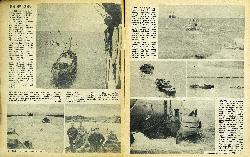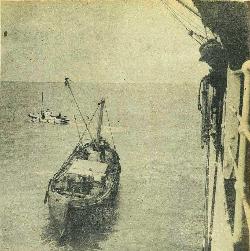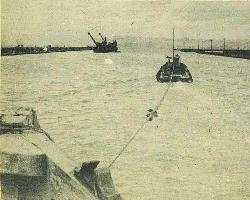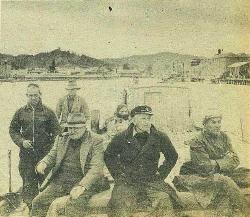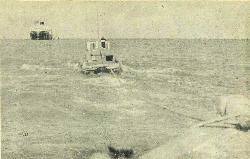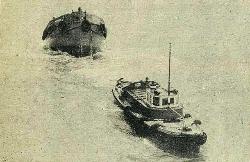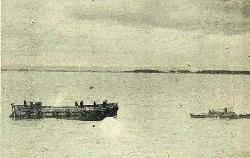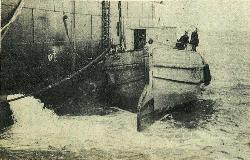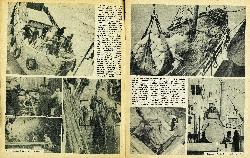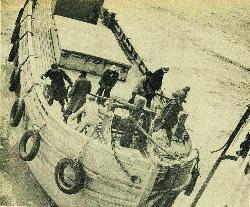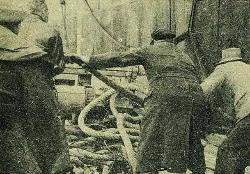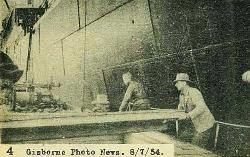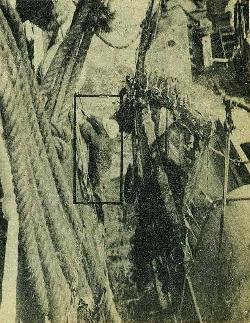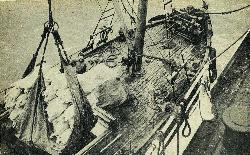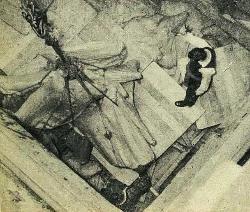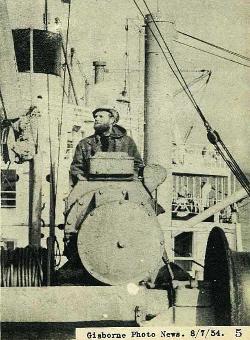2
Home Boat Cargo
*27,515 carcases Lamb.
*5743 carcases Mutton.
*4557 quarters Beef.
*3520 sides Pork.
*4255 sacks Peas.
*1900 cartons Preserved Meats.
*366 casks Tallow.
*972 packages Sundries.
*244 bags Hides.
*143 packages Butter.
*125 cases Canned Corn.
*82 casks Pelts.
*25 drums Neatsfoot Oil.
*6 casks Calfskins.
Impressive figures, these. They add up to the cargo loaded into the "wairangi" from the Gisborne roadstead during the week she was at anchor here, from May 22 to May 29.
But figures are not impressive except in terms of human endeavour. "Photo News" was curious to know just how 27,515 carcases of lamb & all those other thousands of items are shifted from the wharf to the ship riding at anchor 2½ miles out to sea. So we went out on a lighter—and learned a lot.
Once aboard the lighter, we headed past the seawall and the dredge, towed by a spunky little launch. Day was overcast with a fresh southerly. Our companions going out to work lighter at ship side included at least one man also making his first trip. Pat O'Connor (left) looked after us, and saw us safely aboard the Wairangi. Above, our camera, safely esconsced on board, recorded the scene as another precious cargo arrived for unloading.
3
Out in the Open, we headed for the Wairangi, standing high on the long Pacific swell. To the landlubber from "Photo News", work was getting increasingly difficult. He was in need of more than a camera to hold on to, as the lighter pitched and tossed on the swell. Tow rope was often submerged in sea as launch strained at its task.
Picture at left gives some indication of the boisterous conditions in which lighters often lie alongside. The ship is not much affected by the swell, but the lighters bob and bounce with every wave, making work difficult for all except the experienced. On the day we were there, although conditions were described as reasonable, several men were violently ill.
Experienced men, on the other hand, seem to be little affected by the hard work of loading the slings as the deck rolls constantly beneath them.
4
When the lighter arrived alongside the Wairangi, what appeared to the uninitiated eye as a desperate struggle began to get mooring lines aboard and fixed. But experienced hands soon had the craft secure, and turned to the task of opening the hatches in preparation for unloading. Old motor tyres on lighter take shocks as it bumps against ship's side.
Bottom right picture shows how men board ship. Square encloses man scaling rope ladder. Operation needs fine sense of timing. "Photo News" visitor was told to "jump for the ladder while the bow is up and in, and go for your life." His camera bag was sent up on a separate rope. He was pleased to be off bucking lighter and on relatively steady deck of the Wairangi.
5
With the Lighter securely roped to the ship, all that remains to be done is to get on with the business of loading those 27,515 carcases of lamb, 5743 carcases of mutton, etc., etc. Above, the winch hauls up a slingful of mutton. Below, a vertical view down the hold being loaded with quarters of beef. Man in hold is giving signal, which is relayed to bearded winchman (right).
At this stage, "Photo News" received a call to say a return passage was waiting, so it was down the rope and back to Gisborne. We brought home with us a healthy respect for the men who load the "home boats" out in the roadstead.


